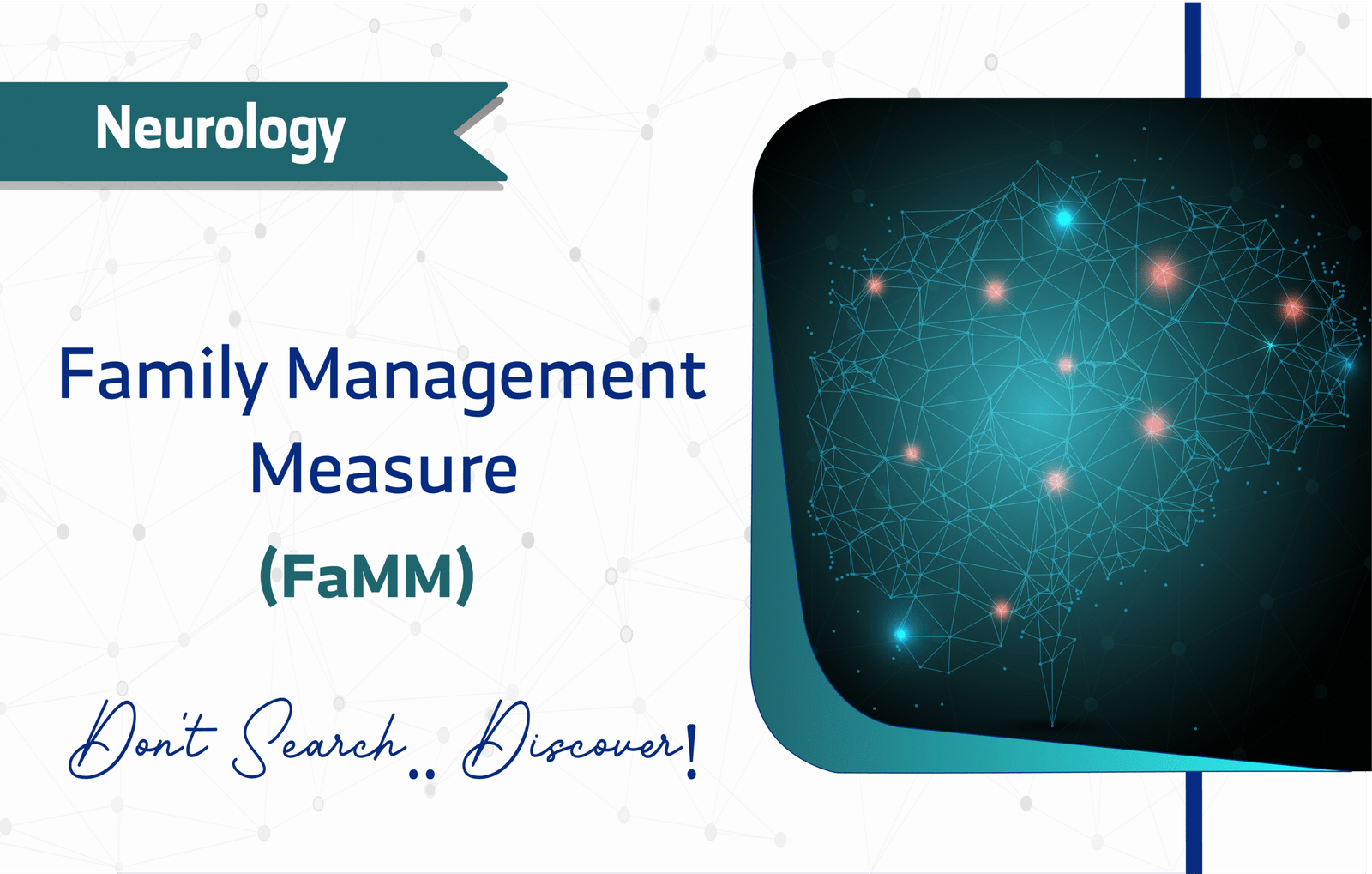Introduction
Managing a child’s chronic illness presents unique challenges for families, necessitating robust tools to evaluate family dynamics and care strategies. Consequently, the Family Management Measure (FaMM), developed by Kathleen Knafl, Janet Deatrick, Agatha Gallo, Jane Dixon, and Margaret Grey in 2009, stands out as a critical tool in pediatric healthcare. Published by the University of North Carolina School of Nursing and Oxford University Press, the FaMM has earned over 400 citations on Google Scholar, highlighting its importance in research and clinical practice (Knafl et al., 2011).
Therefore, this guide provides a comprehensive overview for experts, exploring the FaMM’s features, applications, and significance in pediatric chronic care.
Key Features of the Family Management Measure (FaMM)
Purpose and Use
The FaMM assesses how families manage the care of a child with a chronic condition. Specifically, it evaluates parents’ perceptions of daily family life, roles, and condition management. As a result, it proves invaluable for pediatric chronic illness research and family health assessments. Moreover, clinicians use it to tailor interventions, enhancing family coping and care strategies.
Target Population
The FaMM targets parents of children with chronic conditions, applicable to adults aged 18 and older, including young adults (18–24), middle-aged adults (25–44), older adults (45–64), and seniors (65+). Although not designed for children or adolescents, its focus on parental perspectives makes it highly versatile in pediatric care settings.
Structure
The FaMM includes 53 questions organized into six subscales:
- Child’s Daily Life (5 items): Assesses the condition’s impact on the child’s daily activities.
- Condition Management Ability (12 items): Evaluates the family’s competence in managing the condition.
- Condition Management Effort (4 items): Measures the effort required for condition management.
- Family Life Difficulty (14 items): Gauges challenges in family functioning.
- Parental Mutuality (6 items): Examines agreement between parents on care strategies.
- View of Condition Impact (4 items): Explores perceptions of the condition’s broader impact.
Each item employs a 5-point Likert scale (1 = strongly disagree, 5 = strongly agree), Multiple Choice and Rating Scale, ensuring detailed and nuanced data collection.
Scoring Method
The FaMM uses a 5-point Likert scale, with each subscale scored separately. Notably, higher scores reflect more positive perceptions, except for subscales measuring difficulty or effort, where higher scores indicate greater challenges. Additionally, items marked with an asterisk require reverse coding. Since there is no summary score, researchers and clinicians analyze subscale scores individually to gain insights into specific aspects of family management. Although cut-off scores are not standardized, subscale-specific interpretations guide clinical and research applications effectively.
Administration Format
The FaMM takes 15 – 30 minutes to administer, making it highly efficient. It can be conducted via:
- Paper-based forms
- Digital (Online) platforms
- In-person (Interview)
To ensure accurate application, administering and interpreting the battery may require basic training and familiarity with psychosocial assessments is recommended. This requirement helps maintain consistency and reliability in its usage.
Applications of Family Management Measure (FaMM)
The FaMM provides significant value in multiple contexts:
- Screening: Identifies family management challenges in pediatric chronic care.
- Monitoring: Tracks changes in family dynamics over time.
- Research: Supports studies on family adaptation to conditions like epilepsy, diabetes, and cancer.
- Treatment Planning: Guides clinicians in developing family-centered interventions.
Thus, its comprehensive approach enhances both clinical decision-making and research outcomes.
Languages and Availability
To support global use, the FaMM is available in multiple languages, including:
- English
- Mandarin Chinese
- Spanish
- French
- Portuguese
- More than 5 language and other translations available upon request via the UNC Nursing Office.
This multilingual accessibility ensures its utility across diverse clinical and research contexts worldwide.
The FaMM is lying under Proprietary license, it is free for non-commercial use, making it accessible for most researchers and clinicians. However, commercial or funded academic projects require permission from the University of North Carolina School of Nursing. For inquiries, contact nursingresearch@unc.edu.
Reliability and Validity
The FaMM is recognized as a highly reliable and valid instrument for assessing family management of pediatric chronic conditions. Its psychometric strength is demonstrated by a solid Cronbach’s alpha of 0.72–0.91 across subscales, indicating good to excellent internal consistency. Furthermore, it exhibits strong test-retest reliability with a correlation coefficient of r = 0.80, confirming its stability over time.
Validation Studies:
Limitations and Considerations
However, despite its strengths, the FaMM has a few limitations:
- Self-report Measure: As a self-administered tool, responses may be subject to individual interpretation and bias.
- Social Desirability Bias: Participants may answer in ways they perceive as favorable, potentially compromising the accuracy of responses.
- Length: With 53 items, the questionnaire may be time-consuming and burdensome for some families.
- Complexity: The presence of multiple subscales requires separate scoring and interpretation, which can complicate administration and analysis.
- Cultural Bias: The tool may not fully capture family management dynamics across different cultural settings without appropriate adaptation.
- Limited Validation Studies: While initial validation supports its use, more research is needed to confirm its psychometric properties across diverse populations.
Therefore, clinicians and researchers should complement the FaMM with qualitative assessments or culturally tailored tools when necessary.
Other Versions and Related Questionnaires
Alternative Versions of FaMM
- FMSF-SF: A shorter version of the FaMM, designed for rapid assessments in time-constrained settings.
Complementary Questionnaires
- Family APGAR – assesses perceived family support.
- Family Assessment Device (FAD) – evaluates family functioning across multiple dimensions.
- Family Management Style Framework (FMSF) – theoretical foundation of the FaMM.
- Pediatric Quality of Life Inventory (PedsQL) – measures health-related quality of life in children.
- Impact on Family Scale – assesses the effect of a child’s illness on the family.
- Child’s Daily Life – captures the child’s everyday functional experiences.
- Condition Management Ability – evaluates perceived competence in managing a condition.
- Condition Management Effort – assesses the amount of effort required by families in managing a condition.
- Family Life Difficulty – measures perceived difficulty in maintaining family life.
- View of Condition Impact – assesses family members’ perception of the illness impact.
- Parent Mutuality – evaluates the degree of shared management and cooperation between caregivers.
Additional Resources
For more information on the FaMM and to access the full questionnaire, visit the following resources:
- Access the FaMM questionnaire as a PDF
- For inquiries, contact Kathleen Knafl or nursingresearch@unc.edu
- For additional FaMM resources, consult University of North Carolina School of Nursing
- FaMM item-scale allocations
- Recent Application in Clinical Practice – SAGE Journals
Frequently Asked Questions (FAQ)
- Who can use the FaMM?
Researchers, clinicians, and healthcare providers use the FaMM to assess parents of children with chronic conditions. - How long does it take to complete the FaMM?
Parents typically take 15–30 minutes to complete the FaMM, depending on their familiarity with the questions. - How is the FaMM administered?
The FaMM supports administration via paper-based, digital (online), and interview (in-person) formats, offering flexibility for users. - Is there any cost to using the FaMM?
The FaMM is free for non-commercial use, but commercial use requires permission from the University of North Carolina School of Nursing.
A word from ResRef about Family Management Measure (FaMM)
The Family Management Measure (FaMM) provides nuanced insights into family management dynamics, making it a powerful tool for clinicians and researchers working in pediatric chronic care. It is a robust tool for assessing family adaptation to chronic illness, though clinicians should consider its length and cultural applicability.
References
- Knafl K, Deatrick JA, Gallo A, Dixon J, Grey M, Knafl G, O’Malley J. Assessment of the psychometric properties of the Family Management Measure. J Pediatr Psychol. 2011 Jun;36(5):494-505. Epub 2009 May 18. PMID: 19451173; PMCID: PMC3131701. (link)
- Bousso RS, Ichikawa CRF, Misko MD, Santos MRD, Baliza MF, Mendes-Castillo AMC, Bianchi ERF. Validation of Family Management Measure for the Brazilian culture. Rev Bras Enferm. 2017 Nov-Dec;70(6):1151-1158. English, Portuguese. PMID: 29160474. (link)
- Hutton, A., Munt, R., Aylmer, C., & Deatrick, J. (2012). Using the Family Management Measure in Australia. Neonatal, Paediatric and Child Health Nursing, 15(2), 17-25. (link)
- Van Riper M, Knafl GJ, Barbieri-Figueiredo M do C, et al. Measurement of Family Management in Families of Individuals With Down Syndrome: A Cross-Cultural Investigation. Journal of Family Nursing. 2020;27(1):8-22. (link)








